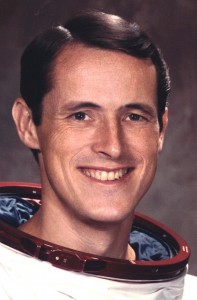
Alumnus Edward Gibson ‘59 helped UR become a partner school with the ASF. Courtesty of wikipedia.org
For years, Americans made it a goal to put a man on the moon. In the decades following that accomplishment, scientists aimed to explain various phenomena in space. Now, launch vehicles are being sent into outer space to see if life exists on other planets. This may not be the typical UR student’s research project, but it certainly could be in the future.
Alumnus Ed Gibson is proof. He graduated from the UR in 1959 and went on to become an astronaut. He was inducted into the Astronaut Hall of Fame in Orsino, Florida in 1997.
As a form of giving back to his alma mater — which he claims nurtured him through years when he considered himself an “at-risk student” — Gibson has helped UR become one of the partner schools of the Astronaut Scholarship Foundation (ASF).
Gibson expressed that only a school with both a heart and exceptional academic abilities would have allowed him to make the smooth transition between poor high school records to graduating from the California Institute of Technology with a Ph.D.
As an ASF partner, UR will receive a $10,000 scholarship each year from the ASF.
According to Dean of Undergraduate and Physics Research Professor Steven Manly, the tradition began when the astronauts involved in the Mercury Seven mission, which ran from 1959-1963, were told they could not receive monetary awards for their “outreach talks.”
The speeches that the astronauts made to the public about their work and experiences were free, so these men began this foundation in order to pay for their media exposure.
In later years, it evolved into an organization which gives back to others with skyrocketing dreams.
In order for a school to become a partner, the ASF must first invite the school to submit a proposal explaining why they should be considered.
To be eligible, a school must be recognized as a research organization on the cutting edge of science and engineering across many fields, have doctoral programs, show loyalty to the ASF scholarships by nominating strong candidates and produce a high number of scientists, engineers and researchers.
The proposal must then be approved by a group at the ASF. While research is perhaps the most influential factor in the decision, Professor Manly believes there may be something else involved which is not mentioned in the application.
“It’s an interesting mix of institutions that [the ASF] partners with,” he said. “It’s my opinion that all these schools must have a connection to one of the astronauts on the Mercury Seven mission.”
Dean of Research and former Dean of the Physics Department Paul Slattery agrees.
“If you look at the list of schools in this program, they are not schools that you usually see listed together,” he said.
The students who are chosen for these honors are no ordinary scholars.
“[The scholarship] is inherently for the benefit of undergraduates. [It is] an award for the best students among those who participate in research. It attracts exceptional people,” Slattery said.
Only two students’ names per school may be submitted each year, and only one is awarded the scholarship.
UR’s panel made its decision of nominees shortly after the proposal was accepted by the National Science Foundation. Junior Mark Levin’s passion for chemistry and contributions to the field helped him earn one of the nominations, although he didn’t even know about the scholarship until after he was notified of his nomination.
“Although you do have to be nominated in order to apply, this scholarship is not about what you can give but rather about your drive,” Levin said. “It’s more about the individual and their passion, so there’s more of a distinction there.”
Slattery seems to agree.
“They’re apt to choose people like themselves…based off their profiles,” he said. “They want interesting people, not just good students.”
Junior Darcey Riley, the other nominee from UR, has declared three majors — computer science, mathematics and linguistics — and her professors speak highly of her academic motivation and driven determination.
“Our good students are competitive with anyone, anywhere. They just don’t realize it,” Manly said. “This is our first year being invited to nominate students among the [science, technology, engineering and mathematics] departments, so we hope for more applications next year.”
Acosta is a member of
the class of 2012.
